1.A New Weapon Against a Deadly Cousin of TB
Scientists at Hackensack Meridian’s Center for Discovery and Innovation (CDI) have engineered a promising drug candidate to combat Mycobacterium abscessus—a rising threat to immunocompromised individuals and those with lung diseases like cystic fibrosis. Published in PNAS, their work reimagines a classic antibiotic to tackle this resilient infection.
2.The Rifamycin Revolution: Overcoming Decades-Long Resistance
Rifamycin antibiotics, developed in the 1960s, once revolutionized tuberculosis (TB) treatment. However, M. abscessus evolved resistance to these drugs, leaving vulnerable patients with limited options. Worse, cystic fibrosis patients often face dangerous drug interactions with existing treatments.
3.Five Years of Precision Drug Design
Using methodical chemical redesign, the team modified rifabutin—a rifamycin antibiotic—to overcome resistance. Over five years, they crafted analogs that maintain potency, improve oral absorption, and eliminate harmful drug interactions. Two compounds stood out in lab and animal tests, showing exceptional efficacy against M. abscessus.
4.Beyond M. abscessus: A Broader Impact
While targeting M. abscessus—a growing danger in cystic fibrosis communities—the new rifamycins also show promise against other mycobacteria, including TB and Mycobacterium avium complex (MAC). This dual potential could reshape treatment for multiple stubborn infections.
5.Collaboration Across Continents
The breakthrough stems from a decade-long global effort. Teams from the National University of Singapore, the University of Minnesota, and Colorado State University contributed key insights. “This is a triumph of academic collaboration,” said CDI’s Thomas Dick, Ph.D., highlighting work by medicinal chemist Tian Lan and immunologist Mercedes Gonzales-Juarrero.
6.Why Environmental Factors Matter
Recent studies suggest environmental metals in water may heighten infection risks for cystic fibrosis patients. As M. abscessus spreads, understanding these links becomes urgent—a challenge the NIH continues to explore.
7.Next Steps: From Lab to Clinic
The lead drug candidate will now advance to IND (investigational new drug)-enabling studies. “This marks a critical step toward second-generation rifamycins with enhanced efficacy,” said co-author Véronique Dartois, Ph.D. If successful, the drug could enter clinical trials, offering hope for patients with few alternatives.
Source:Hackensack Meridian Health
Date:May 6 2025




